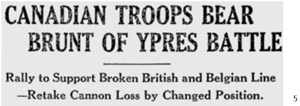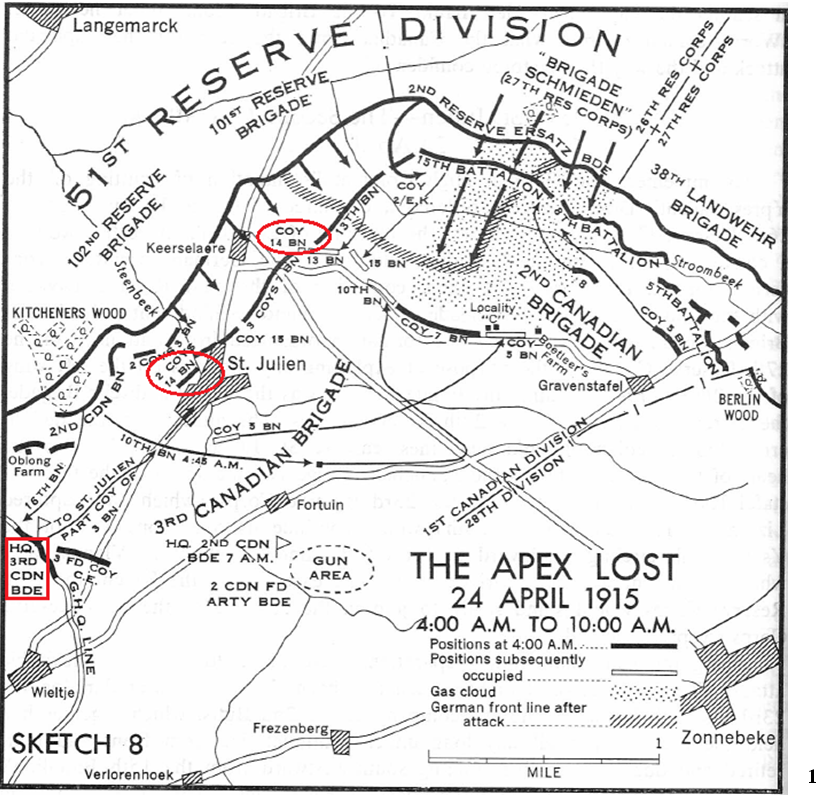Saturday, April 24, 1915
THIS DAY IN RMR HISTORY: “At 3:30 a.m. Saturday, April 24th a very heavy bombardment was opened by the enemy with high explosives & shrapnel on this new line of trenches, which had apparently been accurately ranged by the German Artillery as almost every shell hit. After about two hours of this shelling the men of the two Battalions were forced to retire, having been literally blown out of the trenches. They were rallied beyond the ridge between Poelcappelle Road and Rue des Boches, & occupied every available position there including blastworks, two lines of reserve trenches & several natural folds in the ground. This position was held until about 11:00 a.m. Saturday, April 24th when the line was rendered untenable. The line was then ordered to retire to a selected position about 300 yards to the right rear where there was a line of disused trenches. These were held for nearly an hour & a half until enfiladed by Machine Gun fire & frontal fire from shrapnel. The line was then retired about 200 yards to another position where cover was found in ditches & natural folds in the ground. This was held for some time until what was left of the 13th & 14th Bns. were ordered to retire behind the G.H.Q. lines, being relieved by British Troops. This order to retire was received about 4:30 p.m. Saturday, April 24th, the enemy at the line having already got some distance south of St. Julien. They appeared in considerable numbers on the road in C23A 5.7 but were turned back by Machine Gun & Rifle fire from the G.H.Q. line and apparently retired in a North Westerly direction. The three Companies of the 14th which had retired behind the G.H.Q. line took up & improved Reserve trenches between St. Jean & the G.H.Q. line. No.1. Coy of the 14th Bn. remained in the trenches in the left sector of the G.H.Q. line until relieved on Monday night, April 26/27. The other companies of the Bn. had meantime been withdrawn to the Transport lines in H5.” [2]
“It was the same all along the western side of the apex. ‘People were being blown up all around us, bodies flying in the air,’ explained H.G. Brewer* of the 14th Royal Montreals. ‘So eventually they just blew us out of that position and we had the order to retire, and retirement was up a long slope right out in the open, no cover at all. The bullets were – well, it was just like being out in a rainstorm. I don’t know how we ever got up, the few of us that did. But by that time we were disorganized and there were 13th and 14th and Engineers and Signallers and everybody all mixed up.’”
* Note: Sergeant Hugh Graham Brewer, later Lieut.-Col. Commanding 2nd Bn., The Royal Montreal Regiment in WWII.
 “(By Associated Press) London, April 24, 12:30 p.m. – Over an arch-like front in Belgian Flanders ten miles long the British troops are locked in a series of engagements with the German forces which recall the fighting of last October. The Battle has unexpectedly developed into one of the most important since the present battle lines were formed months ago. Relentless German attacks are being met with determined resistance on the part of the British.
“(By Associated Press) London, April 24, 12:30 p.m. – Over an arch-like front in Belgian Flanders ten miles long the British troops are locked in a series of engagements with the German forces which recall the fighting of last October. The Battle has unexpectedly developed into one of the most important since the present battle lines were formed months ago. Relentless German attacks are being met with determined resistance on the part of the British.
It is known that the Germans have received reinforcements, and it is suggested in London that their capture of Ypres is preliminary to another fierce attempt to break through to the English Channel.
The British official statement says that the British troops are fighting to regain the ground they were forced to yield to the Germans. The loss of the British position, compelled the Canadian division to fall back. The Canadians lost four pieces of artillery, but captured them in a fierce counter attack, carried on in face of heavy losses, but which official dispatches describe as successful.
Berlin is elated at the German victory, the papers of the city saying that it evens the score of the defeat of Neuve Chapelle.
Driven from Hill 60, south of Ypres, and failing to retake it in a counter attack, the Germans launched a sudden advance northeast of the town, and after a cannonade, in which the British declare shells containing stupifying gases were used, drove a wedge of infantry across the Yser canal, and forcing the allies to a new conformation of their lines.” [6]
CANADIANS COMMENDED
For Speed in Digging Themselves in After Charges
“London, April 24 – The Daily Mail’s correspondent in Northern France, in a despatch describing the British attack on Hill No. 60, southeast of Ypres, says:
‘The British success was due largely to the speed of the tunnel engineers, for the explosion of the British mines, anticipated by only a short time a similar move planned by the German engineers. Hill No. 60 is only 200 yards long. The fighting here has been more terribly concentrated than in any spot in history. The whole hill is mined, trenched, sand-bagged and covered. Some of the enemy’s trenches are still virtually on the hill within twenty yards of our trenches.
“The Canadian troops have been specially commended by the British commanders for the speed and precision with which they dug themselves in after charging.’” [7]
[1] Col. G.W.L. Nicholson, CD., Official History of the Canadian Army in the First World War: Canadian Expeditionary Force 1914-1919, Duhamel, Queens Printer, Ottawa,1962, pg. 72.
[2] Operation-Report of May 6th, 1915, War Diary, 14th Canadian Battalion, The Royal Montreal Regiment, Library and Archives Canada, Ottawa. http://data2.collectionscanada.ca/e/e044/e001089724.jpg
[3] C.B.C. series “Flanders Fields” written and produced by J. Frank Willis, edited by Frank Lalor, Toronto, 1964, program 5, transcript page 16. As quoted by J. McWilliams and R.J. Steel in “Gas; The Battle For Ypres, 1915,” St. Catharines, Ontario, Vanwell Publishing Ltd., 1985, pg. 113.
[4] Col. G.W.L. Nicholson, CD., Official History of the Canadian Army in the First World War: Canadian Expeditionary Force 1914-1919, Duhamel, Queens Printer, Ottawa,1962, pg. 74.
[5] “Canadian Troops Bear Brunt of Ypres Battle,” Nashua Telegraph, Nashua, New Hampshire, Saturday, April 24, 1915, pg. 1, col. 6.
[6] Ibid
[7] “Canadians Commended,” The Gazette, Montreal, Quebec, Saturday, April 24, 1915, pg. 1, col. 2.
[highlight align=”left, right, center” style=”default, different”]THIS DAY IN RMR HISTORY is researched and written by Captain (retired) Hamilton Slessor. His mandate is to tell the story of The Royal Montreal Regiment (RMR) and Canada’s experiences in the First World War for a one-year period (01 August 1914 – 31 July 1915). Details of all aspects of the Canadian Army’s experience are recounted here. You can follow the daily digest here on the RMR Foundation’s website, on Facebook, or by subscribing for a daily delivery to your email inbox. The RMR Foundation also worked with Global Montreal to produce a series of short videos about Canada’s participation the the Great War. [/highlight]



